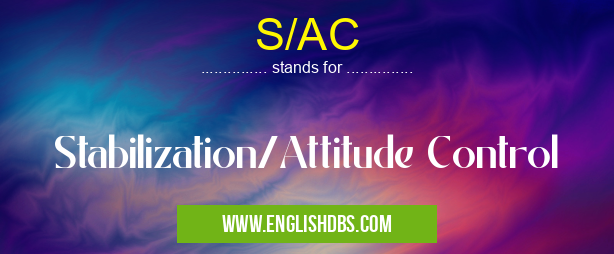What does S/AC mean in NASA
Stabilization/Attitude Control (S/AC) is an aerospace term that refers to the act of controlling the rotation and orientation of aircraft, spacecraft, or satellites. This control is achieved by monitoring the system motions with sensors and then utilizing actuators to apply corrective forces. The aim of S/AC systems is to maintain desired attitudes in any dynamic environment.

S/AC meaning in NASA in Governmental
S/AC mostly used in an acronym NASA in Category Governmental that means Stabilization/Attitude Control
Shorthand: S/AC,
Full Form: Stabilization/Attitude Control
For more information of "Stabilization/Attitude Control", see the section below.
» Governmental » NASA
Essential Questions and Answers on Stabilization/Attitude Control in "GOVERNMENTAL»NASA"
What Is Stabilization/Attitude Control?
Stabilization/Attitude Control (S/AC) is a type of control system used in aerospace systems such as aircraft, spacecraft, and satellites. It involves controlling the rotation and orientation of these systems using sensors to monitor motion and actuators to apply corrective forces.
What Is the Aim of S/AC Systems?
The goal of S/AC systems is to maintain desired attitudes even when a dynamic environment presents changing conditions. This can be used for both static attitude control, such as during flight patterns, or maneuverable attitude control that allows for directional changes mid-flight.
How Is Attitude Controlled?
Attitude control relies heavily on feedback from sensors that measure acceleration and angular velocity in all 3 primary axes. These readings allow for actuators to adjust angles around those axes in order to achieve the desired attitude. Additionally, momentum wheels are often used for controlling an axis over time.
What Are Some Common Applications of S/AC?
S/AC systems have many applications across multiple industries including robotics, entertainment technology, automotive industry, maritime navigation, climate research, space exploration and mapping operations.
How Does An S/AC System Function In a Dynamic Environment?
To function properly in a dynamic environment an S/Ac system must be able to make informed corrections quickly without sacrificing accuracy or performance due to its constantly changing conditions. To do this it relies heavily on complex algorithms designed specifically for this purpose so that it can anticipate changes faster than they happen in order to maintain its desired attitude or orientations at all times.
Final Words:
Stabilization/Attitude Control (S/AC) systems are a critical part of many aerospace programs which help aircrafts stay stable while flying as well as providing them with the necessary navigational data needed for operation in dynamic environments. The ability to maintain accurate attitudes over long periods at varying speeds has been instrumental in advancing air traffic safety standards worldwide for pilots and passengers alike.
